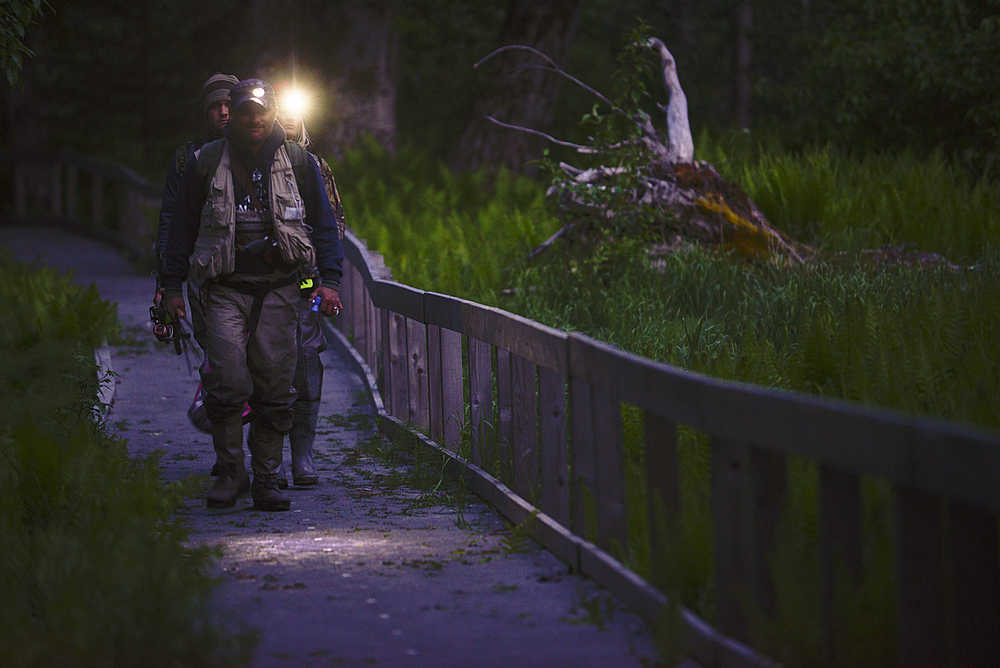The U.S. Fish and Wildlife Service may pick up a project to restore the riverbanks near the Kenai River and Russian River confluence.
The Kenai National Wildlife Refuge released a Draft Environmental Assessment in December 2015 for several projects that would address tourism-related bank degradation in the Kenai-Russian River Complex, a five-mile radius from the confluence of the two rivers.
The heavy foot traffic for shore activities damages the riverbank vegetation, riparian function, fisheries and archaeological resources and increases erosion. The proposed projects would restore some of the bank vegetation to repair the damage to the river’s habitat as well as protect the cultural artifacts downstream of the ferry landing on the Kenai River’s south shore.
The project is a return to a bank stabilization project originally designed in 1999. An initial phase completed in 2006-2007 stabilized the bank on both sides of the Kenai River and constructed fences and stairways to preserve some of the vegetation re-established there. However, a lack of funding stopped Fish and Wildlife from stabilizing the bank downstream of the ferry landing on the Kenai River’s south bank and from installing an elevated boardwalk.
With the funding secured, Fish and Wildlife intends to move forward with the project. Besides the revegetation of the bank, the workers would install light-penetrating access stairways, a wooden fence to direct visitors and a light-penetrating walkway along the top of the bank.
“Wildlife-oriented recreation would continue to be the major use of the area with enhanced interpretive facilities designed to increase visitor understanding and appreciation of the area’s natural and cultural resource values,” the assessment states.
The improvements are not meant to draw more traffic, said Matt Conner, the chief of visitor services for the Kenai National Wildlife Refuge. Instead, they are meant to reduce the impact of the visitors that are already coming, he said.
Restoring the vegetation to the damaged parts of the bank could help stabilize it, helping restore the fish habitat as well as protect cultural sites in the area that may or may not be accessible to the public at the moment, he said.
“What this project is going to do is put that habitat back to where it is supposed to be,” Conner said. “We really don’t want that bank sloughing off and losing (that cultural resource).”
The estimated cost for the project, excluding the light-penetrating boardwalk, is $275,000. The cost for installing the boardwalk, which would extend along the entire length of the revegetated area, is currently unknown, according to the assessment. Conner said the price for the boardwalk will be determined when the project goes out to bid.
The project does draw from some of the refuge’s funds, but most of the payments come from special service fees, such as parking lots and cabin fees.
“That’s the cool thing about this,” Conner said. “We try to take those fees from special services and put them right back into special services.”
One of the goals of the project has been to improve the fish habitat in the area. The original environmental assessment in 2006 said the project would improve fish habitat along the bank and stop further erosion, mostly focusing on king and coho salmon fry while they are in the river and encouraging more to return in the future.
The confluence of the Kenai and Russian rivers is the busiest sockeye sport fishery in the state. Some 70,000 people visit this area annually, with the majority coming to fish, according to the assessment. If Fish & Wildlife does nothing, loss of bank vegetation in the project area would continue and thus damage fish habitat.
The sockeye runs to the Russian River are fairly stable, according to Alaska Department of Fish & Game weir data — both the early run and late run have met their escapement goals over the last decade. The environmental assessment states that the construction would likely not disturb the fish too much.
“The overall impact on anadromous and resident fish (from the construction) would probably be minor; severe impacts are avoided by insuring state regulations are adhered to,” the assessment states. “Rehabilitation and revegetation of the riverbank will improve the quality of the riparian area and aid in the survival rates of young fish.”
Conner said after the bank vegetation has been restored, the refuge will maintain it, possibly with the assistance of volunteer groups.
The environmental assessment is currently in draft. After comments have been received from the public and reviewed, Fish and Wildlife will decide whether to pursue the development. Public comment is open until March 26.
If Fish and Wildlife does move forward with the project, the hope is to have it finished before June 11, Conner said. If it cannot be done before then, it will likely be postponed until after the season, during the fall, he said.
“We don’t want to be doing this during the season,” Conner said. “That would be a nightmare.”
Reach Elizabeth Earl at eliabeth.earl@peninsulaclarion.com.

